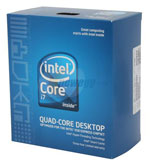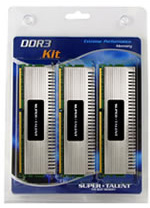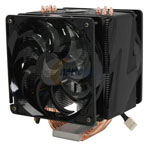Intel Performance Midrange
In recent months, AMD is finally effectively competing in midrange computer systems. With the AMD Phenom II line, Intel and AMD enjoy rough parity in the price ranges and processor speeds where they compete. Of course, the top AMD still cannot compete with Intel Core i7, which remains the performance leader. We could have chosen an Intel CPU for our performance midrange that would have competed very well with the AMD Phenom II 955BE used in the AMD performance midrange setup. The problem with that is we would not make that choice ourselves. If we were spending $1600 or more a system, we would definitely stretch the extra $150 to buy a Core i7-920 system. That is exactly what we did for the Intel performance midrange system. (You can of course trim down other component choices to get into a Core i7 system for less money, but we're going with the type of system we would like to build.)
The reasoning was very simple. It was difficult to recommend another Intel system at anywhere close to the price point of the i7-920, and socket 1366 components have been dropping in price over the past three months. For those reasons if you plan to spend over $1000 on a base Intel box you should definitely consider a Core i7-920 system. That will likely change with the coming i5 release providing additional Intel midrange choices.
| Intel Performance Midrange PC | ||
| Hardware | Component | Price |
| Processor | Intel i7 920 Nehalem Socket 1366 (2.66GHzx4 4x256MB L2, 8MB L3 Cache) | $280 |
| Cooling | Vigor Monsoon III LT for Socket 1366 | $55 |
| Motherboard | GIGABYTE GA-EX58-UD3R LGA 1366 Intel X58 ATX (after $15 rebate) | $180 |
| Video | MSI Radeon HD 4890 1GB OC Edition (After $30 Rebate) | $170 |
| Memory | Super Talent Chrome 6GB DDR3-1600 Triple Channel Kit WB160UX6G8 8-8-8-18 | $96 |
| Hard Drive | Western Digital Caviar Black 1TB WD1001FALS | $95 |
| Optical Drive | LG BD/HD DVD 8X BD read/16x DVD read/write CH08LS10 - Retail | $130 |
| Audio | On-Board | $ - |
| Case | Cooler Master Storm Scout SGC-2000-KKN1-GP Mid-Tower | $100 |
| Power Supply | Corsair CMPSU-750TX 750w 80 PLUS Certified SLI/Crossfire Ready Core i7 Power (after $20 Rebate) | $100 |
| Base System Total | $1206 | |
| Display | ASUS VW266H Black 25.5" 2ms(GTG) HDMI Widescreen LCD Monitor (1920x1200) (after $30 Rebate) | $300 |
| Speakers | Logitech G51 155 watts RMS 5.1 Surround Sound Speakers - Retail | $120 |
| Input | Microsoft CA9-00001 Black PS/2 Standard Keyboard and Optical USB/PS2 Mouse - OEM | $16 |
| Operating System | Microsoft Vista Home Premium OEM | $99 |
| Complete System Bottom Line | $1741 | |
| SSD (Optional) | OCZ Vertex OCZSSD2-1VTX120G 2.5" 120GB SATA II MLC Internal Solid State Disk | $339 |
 |
The i7-920 is the lowest priced Intel Core i7 you can currently buy. The other choices, even after the recent i7-975 and i7-950 introductions, are in the $562 to $1000 range. Don't assume, however, that the 920 isn't a powerful processor. The i7-920 is capable of reaching the performance levels of the top i7 CPUs, because it has also proven to be a dynamite overclocker for those who care about that - provided they are also willing to provide decent cooling to the i7-920.
The Core i7-920 is 30% faster in some parameters than a Core 2, and you can overclock this 2.66GHz CPU to 3.8GHz to 4GHz with careful tweaking and better cooling. As shown in the Phenom II launch, the 920 reached as high as 3.8GHz at stock voltage and 4.0GHz when overvolted to 1.35V. That is a 50% overclock without a ton of effort on air-cooling. You will certainly be very happy with Core i7 base performance, but if you are interested in overclocking you will be extremely pleased with this CPU.
 |
The GIGABYTE GA-EX58-UD3R remains the X58 board of choice for the Core i7-920. It is one of the least expensive X58 chipset motherboards currently available. Others have joined that +/-$200 X58 club in recent months, but the GIGABYTE still provides excellent value and is now selling with a rebate that reduces the price to $180. Test results and user reports for the GIGABYTE EX58-UD3R are very favorable. This low-priced X58 board also excels in overclocking, which is why it remained the motherboard choice for the performance midrange Intel system. Other good choices are the MSI X58 Pro LGA 1366 and the ASRock X58 Deluxe LGA 1366.
 |
Super Talent introduced an excellent 6GB triple-channel memory kit in their Chrome DDR3-1600. This Super Talent 6GB kit is another low-voltage memory kit preferred in AnandTech memory testing. Specifications are 8-8-8-18 timings at DDR3-1600 and 1.65V. This triple-channel memory kit provides excellent value in a 6GB kit and overclocking headroom to spare with its low voltage design. Six months ago in our last midrange guide, a slower 6GB kit set you back $145 where the Super Talent DDR3-1600 is now $96. DDR3 prices just continue to drop. You can select from a number of quality memory suppliers, but make sure to include their warranty and customer service reputation in your decision-making.
 |
Unfortunately, the Core i7 CPU runs hot and eats lots of power. In fact, the stock Intel HSF is barely adequate for the CPU, which is a change in philosophy from lower Intel processors. For those reasons we almost always recommend a third party CPU cooler for an i7 system - particularly if you plan to overclock at all. Our cooler choice to mate with the GIGABYTE X58 board is the Vigor Monsoon III LT at $55. This Monsoon is a standard vertical heatpipe air-cooler, with effective and quiet push-pull cooling. The Monsoon appears a good match to the OC capabilities of the i7-920. Another excellent option is the Thermalright Ultra 120 eXtreme with the 1366 mounting kit. You pay a bit more for the Thermalright cooler, but this top Core 2 cooler also works very well when paired with a Core i7.










71 Comments
View All Comments
SiliconDoc - Wednesday, August 5, 2009 - link
The idea that the 4870 or the 4890 beats the GTX275 is a FANTASY.-
http://www.driverheaven.net/reviews.php?reviewid=7...">http://www.driverheaven.net/reviews.php?reviewid=7...
http://www.bit-tech.net/hardware/graphics/2009/04/...">http://www.bit-tech.net/hardware/graphi...03/radeo...
http://www.bjorn3d.com/read.php?cID=1539&pageI...">http://www.bjorn3d.com/read.php?cID=1539&pageI...
http://www.dailytech.com/422009+Daily+Hardware+Rev...">http://www.dailytech.com/422009+Daily+H...adeon+HD...
http://www.guru3d.com/article/geforce-gtx-275-revi...">http://www.guru3d.com/article/geforce-gtx-275-revi...
http://www.legitreviews.com/article/944/15/">http://www.legitreviews.com/article/944/15/
http://www.overclockersclub.com/reviews/nvidia_3d_...">http://www.overclockersclub.com/reviews/nvidia_3d_...
http://www.hardwarecanucks.com/forum/hardware-canu...">http://www.hardwarecanucks.com/forum/ha...a-geforc...
http://hothardware.com/Articles/NVIDIA-GeForce-GTX...">http://hothardware.com/Articles/NVIDIA-GeForce-GTX...
http://www.engadget.com/2009/04/02/nvidia-gtx-275-...">http://www.engadget.com/2009/04/02/nvid...275-ati-...
http://www.overclockersclub.com/reviews/nvidia_gtx...">http://www.overclockersclub.com/reviews/nvidia_gtx...
http://www.pcper.com/article.php?aid=684&type=...">http://www.pcper.com/article.php?aid=684&type=...
-
If you're spending $700.00 to $1,600 dollars and a $15 difference on one of your most important components, the videocard, makes your mind up for you... well...
---
NVidia often has 1 or TWO free games with it at the egg - while the red card far less often has just 1. There's another $50 - or $100, going with Nvidia - because of course with either card that makes it a GAMING system - and one would need some games.
---
I wasn't surprised that EVERY CARD in EVERY SYSTEM recommended was the red rooster card - considering where we are.
Mirrorblade - Monday, July 27, 2009 - link
Hiya, for HDD choice you write"While there are differences between hard drives, outside of running benchmarks most people aren't likely to notice the difference in performance between Western Digital, Seagate, Samsung, Hitachi, and other major brands." -
but for memory, you recommend an overclocking memory set, where you could easily save some money (and you don't even give an alternative "for the people that will never want to overclock at all).
.. I don't see any point in advising only overclocking stuff. Sure one might want to overclock, but in this case you could add something as an alternativ, not recommend the OC stuff in general.
Wesley Fink - Monday, July 27, 2009 - link
Even if you never overclock the low-voltage designs of the memory we recommend in the Guide will perform well and last a last time. You can certainly substitute lower cost and lower spec'ed memory if that better meets your needs.Search for a standard like DDR2-800 for the DDR2 systems and DDR3-1066 or 1333 for the Performance mid-range systems. Name brand memory with a real warranty is the better choice - even at the low end. If anything goes wrong quality memory suppliers will replace the bad memory quickly and many better companies offer a lifetime memory warranty.
In comparing memory at the same price choose the one that has the tighter timings, like 5-5-5 instead of 7-7-7. At the same timings and price the one that is specified with the lower voltage is generally the better choice.
nafhan - Monday, July 27, 2009 - link
I think they recommended overclocking memory because they are recommending overclocking in general at this price point. Notice the processor and motherboard choices are geared towards overclocking as well. If you are definitely NOT going to overclock the value midrange, you could buy cheaper memory, motherboard, and (on the AMD side) a non-black edition CPU. You'd save about $100, and still have a fast, reliable system.It might be interesting if they listed a non-overclocking alternative for those parts (Mem, CPU, MB). Although, that may just push things down into the "budget" system range.
IlllI - Monday, July 27, 2009 - link
can anyone tell me if the OCZ ModXStream Pro is better than the ENERMAX PRO82+ http://www.newegg.com/Product/Product.aspx?Item=N8...">http://www.newegg.com/Product/Product.aspx?Item=N8... ? they are both about the same priceThe0ne - Monday, July 27, 2009 - link
I don't know about the enermax but I've researched before purchasing my OCZ 700W PS. Their lower wattage PS have good reviews except for this one but with the recent updates it's gotten better reviews. It was below average before. Sorry I don't have the link to the website that reviews PS.One thing to keep in mind is that if you're not really going to use the max wattage then I wouldn't worry about it. Also, it's best to know your system configuration and try to get a PS with some buffer wattage just in case....you know like when it ages :)
Wesley Fink - Monday, July 27, 2009 - link
Today's price on the OCZ Modular 600W is $50 after a $20 rebate, or an initial cost of $70. The Enermax is a decent PSU, but current cost is $60 after a $50 rebate or an initial cost of $110.The OCZ slightly higher power rating, modular design, and 3-year warranty tilt the value toward the OCZ. Both units are 80 Plus certified, and OCZ has an excellent reputation for Customer Service.
C'DaleRider - Monday, July 27, 2009 - link
That OCZ ModXStream isn't even in the same class as the Enermax Pro82+. Interior construction----the OCZ uses Chinese off-brand capacitors while the Enermax uses high quality name brand Japanese capacitors.Efficiency----not even a contest, the Enermax by a landslide.
Voltage regulation and ripple/noise suppression----again, the Enermax trounces the OCZ.
In all, the OCZ is a mediocre power supply that failed testing when subjected to temps above 40C. On the other hand, the Enermax is better constructed, more efficient, and flew through testing despite being subjected to temps in excess of 40C.
You make the call.
jonup - Monday, July 27, 2009 - link
First the Enermax comes with $50 MIR. Which is a turnoff for many.Second, I just bought OCZ ModXStream Pro 600W (it should ship today) and I did some reading before I bought it. Non of the reviews had an issue with the performance. It performed as rated or better with stable voltages.
Third, for a midrange system it should be running in less then 400-450. At such output the OCZ if working 2 85-86% efficiency. I am not saying that it is better than the Enermax, but in worst case the OCZ will be behind 1-2% which is immaterial.
erple2 - Monday, July 27, 2009 - link
My system (non-overclocked E6750, radeon 4890, 2 memory sticks etc) eats about 325 W at the wall when running at or near full tilt. Factoring in even the highest efficiency available for my PSU (85%), the system is using about 275W of power. I think that the midrange systems listed here (particularly the lower midrange ones) will be chewing through about 300W at full tilt. So I think that the 600W psu should be more than enough.Yes, you can play games with specific efficiencies at specific wattages, but for that you're going to need to see the charts to make that fine-tuned an estimate. But, most power supplies that I've seen reviews for hit max efficiencies between 30 and 60% utilization.
Also, does that extra few percentage of watts make that much of a difference? I dunno. Turn off a light instead. That will save you more power.